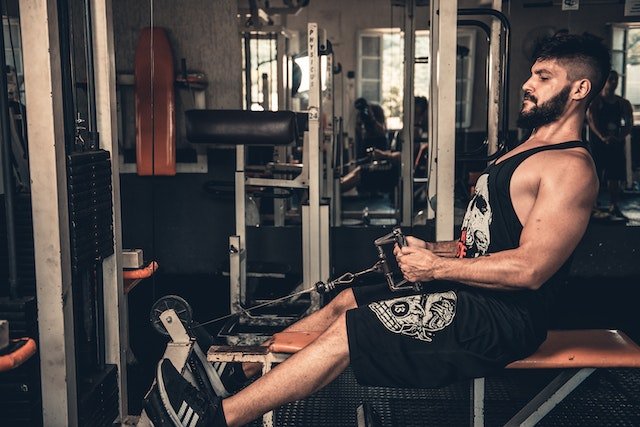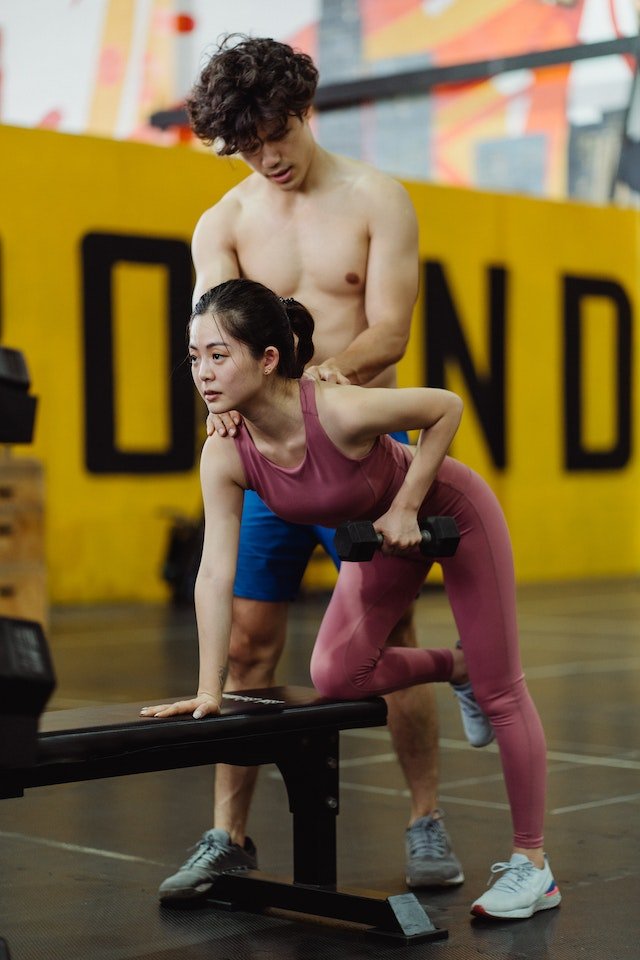
Why Do My Forearms Get Tight When I Do Back Exercises? Find Out Why Here
Have you ever experienced sore or tight forearms after a back workout? If so, you’re not alone; many fitness enthusiasts struggle with this issue.
The good news is that there are some simple solutions to help alleviate your forearm discomfort and prevent further issues from occurring in the future.
In today’s blog post, we’ll be exploring why your forearms get tight when doing back exercises and offering some tips to help keep them feeling loose and comfortable during your next workout session!
Why do my forearms get tight when I do back exercises?
There are a few potential causes of why your forearms get tight when you do back exercises. The main culprit is gripping the bar too tightly. When we grip excessively, our wrists and forearms tend to take all the stress instead of distributing it elsewhere in the body, leading to fatigue and soreness. If lifting is a new activity for you, it can take some time to learn the correct form and for your body to settle down after the initial strain. Another common issue is the position of where you’re holding the handle, or maybe even think about removing your thumb from gripping the bar, as this can lead to wrist flexion which causes tightness in the forearms. It’s also worth spending time strengthening your forearms due to the fact you are getting fatigued in the forearm area. Finally, lifting too heavy or doing too much volume for a given exercise can also lead to sore and tight forearms. It’s important to focus on perfecting your form and connecting with your muscles rather than trying to lift too much weight.
Are you new to lifting?
If you’re new to lifting, it can take some time for your body to adjust and learn the correct form. Not only that, but your body will take time to settle down after the initial strain when beginning a new activity.
You will more than likely encounter DOMS (delayed onset muscle soreness) during this process, as your body isn’t used to the new stimulus that’s being placed on it.
When you first start lifting your muscles, tendons and joints need time to get used to the new movement patterns and weights that you are lifting.
As such, it’s important to pay extra attention to your form and focus on the mind-muscle connection, which helps you recruit the right muscles that are being targeted (more on this later).
This is why it’s important to listen to your body and make sure you’re not pushing yourself too hard too soon.
This may take a while as you adjust to the new stimulus and build up your strength, so don’t worry too much if your forearms get tight if you have just started lifting. As this is quite normal and will settle down after the adjustment period.
Gripping too tight
Gripping too tight is one of the main culprits when it comes to forearm fatigue and discomfort. This is because when we grip too tight, our wrists and forearms end up taking the brunt of the work instead of distributing it elsewhere in the body.
It’s important to pay attention to your form and focus on using muscles in the back to lift (mind-muscle connection) instead of trying to grip too tight.
A quick way to test if you’re gripping too hard would be to clench your fist, and if you cannot open it without putting effort into it and your forearm feels tense and hard, then chances are you’re gripping the bar too hard.
However, gripping the bar is something that most people will do unconsciously, so it’s important to be mindful of your grip and make sure you’re not clenching too hard.
If your forearms are feeling extra tight, it’s obvious that you are gripping too hard and need to ease up.
This will help you to distribute the load of the exercise and make sure that your forearms don’t get too tired and sore.
The other thing is that if you are gripping too hard, you are more than likely not engaging the right muscles for the required exercise, which will lead to a reduced range of motion and potential injury.

Forearm fatigue
Another common cause of forearm fatigue is not having enough grip strength. Grip strength plays an important role when it comes to back exercises such as pull-ups, rows and deadlifts.
It’s important to make sure that you are training your grip strength so that it can handle the weights that you are lifting.
If your grip strength isn’t up to par then it’s likely that your forearms will become fatigued quite quickly.
There are various exercises that you can do to improve your grip strength, such as farmer’s walk, barbell holds, and pinch grip holds.
These are all great exercises to add to your training routine if you want to improve your grip strength and reduce forearm fatigue.
This again would be something newbies may need to consider, as their grip strength might not be up to standard for the weight you are wanting to lift.
Where are you holding the handle?
It’s also important to pay attention to where you are holding the bar, dumbbell or handle when doing any kind of exercise.
Ideally, you want to be holding the bar in your palms rather than in your fingers, as this will help to reduce strain on your forearms and distribute the load more evenly.
To do this, you may need to adjust your grip on the bar or use straps to provide more support and help you keep the bar closer to your palms.
This is because if you grip the bar too tightly with your thumb, it limits your range of motion and can cause discomfort and fatigue in your forearms.
This is something that may take a little time to get used to, particularly if you are new to lifting or you have always held equipment more with your fingers, but it is a very important factor when it comes to reducing forearm fatigue.
Related: Why do I feel lat pulldowns in my chest?
Monkey grip
When you grip the bar, have you ever thought about taking your thumb away from the bar? If not, this is something that you should try.
Removing your thumb from the bar during exercises will not only alleviate pressure on your forearms but also enable a better range of motion.
The best way to think about this kind of grip would be to take your hand and make a claw shape, where the ‘claw’ is your four fingers wrapped around the bar and your thumb pointing away from the bar.
In the fitness community, this is also known as a “suicide grip” or “monkey grip” and has been used by many lifters over the years to reduce forearm fatigue.
This will help to take some of the pressure off your forearms and put more focus on the muscles that you are trying to target.
It’s important to make sure that your wrists remain in a neutral position and that you don’t overstretch them when using this type of grip, as this can lead to injury or overuse.
Remember, you aren’t pulling the weight with your arms, you are pulling the weight with your back muscles. Understanding this will also help you engage the correct muscles when lifting.
Wrist flexion
You might be overusing your wrist muscles if your forearms are always tired. The flexor carpi, palmaris longus, flexor carpi ulnaris, and flexor digitorum are all forearm muscles that can get easily fatigued from too much use.
These muscles are responsible for the movement of your wrist and can become overactive when you start to fatigue during back exercises, such as rows or lat pulldowns.
These muscles are important for both wrist extension and flexion, as well as grip strength, but if they become overworked then it can cause discomfort and fatigue in the forearms.
While it may feel natural to pull a heavy item/weight towards you by flexing your wrists, this will only ultimately result in more strain and fatigue in your forearms, especially if done repeatedly again and again.
When it comes to back exercises, it’s important to maintain a neutral wrist position to help reduce strain on your forearms, because it will take the pressure off them and help you focus on engaging your back muscles instead.
Wrist flexion is also quite common with people when doing barbell bicep curls, which can put your wrists in a vulnerable position and can lead to injury if done too often.
If you find yourself flexing your wrists, adjust your grip on the bar to help keep your wrists in the correct position.
Bending/flexing your wrists to complete a rep is also a telltale sign that you are trying to lift too much weight.
Lifting too heavy
Speaking of lifting too much weight, this is something that can also contribute to forearm fatigue and discomfort.
If the weight you are trying to lift is too heavy for you, your body will start to use other muscles to complete the rep, as well as increase the stress on your joints and ligaments.
This can lead to wrist flexion and an increase in forearm fatigue, which is why it’s important to make sure you are lifting a weight that is comfortable yet challenging for you.
Lifting a weight that’s too heavy will also require you to grip harder to hold onto the barbell or handle, which can cause further strain on your forearms.
It’s important to focus on form first and foremost, and then worry about how much weight you can lift.
Never try to lift a weight that is too heavy for you as it will only show your lack of understanding and inexperience. Instead, start with a comfortable weight and then gradually increase the amount lifted over time.
We have all seen those people in the gym that are lifting way more than they should by exaggerating their range of motion, and this is never a good thing because it leads to bad form and eventually injury.
Mind muscle connection
It’s also important to remember that when it comes to back exercises, you should always be focusing on the mind-muscle connection.
The mind-muscle connection is when you think about the muscle that you are trying to target and focus on feeling it working. This will help with both form, and strength, and will also help you to avoid straining your forearms too much.
Make sure you are engaging your target muscles and feeling the tension in your back, rather than just moving the weight up and down with momentum.
If you are new to lifting or don’t feel too confident with your form, make sure you seek out a certified personal trainer to help you get the most out of your back exercises and ensure you are doing them safely and correctly.
If you don’t do this, over time you could develop bad habits which will lead to injuries and a lack of progress.

Too much volume
If you find your forearms still feel tight after back exercises, then it could be possible that you are doing too much volume.
How often are you training your back or doing pull days?
If you are overtraining or not giving your body enough rest between sets, then this could be the reason why your forearms feel tight.
Maybe you aren’t giving your body enough rest and recovery in between training sessions, which can lead to muscle fatigue and tightness.
Listen to your body and don’t be afraid to take an extra rest day if you need it.
Try to keep your reps, sets, and rest periods as low as possible in order to keep your muscles from becoming overworked and fatigued.
Overworking your forearms can lead to injury, so make sure you are not overdoing it with your back exercises.
Form
Sometimes the reason why your forearms feel tight is because of poor form.
Make sure you are always focusing on form and not just moving the weight up and down with momentum.
When doing exercises like pull-ups, make sure you are controlling your weight on both the eccentric and concentric phase of the exercise.
For lat pulldowns, make sure you are pulling the bar or handles down to your chest and not just bouncing the weight up and down.
Bent-over barbell rows and single-arm rows should also be done with control and focus on the mind-muscle connection.
Additionally, make sure you are gripping the bar or handle correctly. Hold it in the centre of your hands and don’t grip too tightly as this can lead to further strain on your forearms.
When doing back exercises, focusing on form is more important than the amount of weight you’re lifting.
Engaging the target muscles properly will also help to make sure you are getting the most out of your back exercises, whilst avoiding unnecessary strain on your forearms.
Related: Why are pull ups getting harder?
Injury or overuse
If you find yourself constantly getting tight forearms after back exercises, then it could be because of an injury or overuse.
If you do any specific job that involves frequent gripping or using your hands for long periods of time, then this could be causing strain on your forearms and making them tight.
Maybe you have previously recovered from an injury and the muscles in your forearms are still weak.
If you have previously had any type of elbow or wrist injury, then it is possible that your forearms aren’t strong enough yet to handle the weight that you are lifting.
Or maybe the muscles in your forearms have just become overused and need more rest and recovery time.
In extreme circumstances, you could have a case of tendinitis or carpal tunnel syndrome, which would need to be addressed by a qualified medical professional.
Make sure you are seeking out professional help if you suspect you have an injury, and take steps to ensure correct form and technique when training.
It could also be possible that you are just doing too much volume, and not giving your body enough rest and recovery between training sessions.
Make sure you are listening to your body and taking rest days when necessary.
Warm up
Before doing any kind of exercise, make sure you are warming up correctly and preparing your body for the work ahead.
A good warm-up routine should include dynamic stretching, foam rolling and light cardiovascular exercise to get your blood flowing and muscles warm.
Warming up properly before a workout can help to reduce the risk of injury and make sure your body is ready for the exercises ahead.
If you are trying to lift heavy weights without warming up, you are more likely to strain your muscles and experience tightness in your forearms, as well as cause a serious injury in the process.
So make sure you are taking the time to warm up before your workout and giving your body the best chance of performing at its peak.
Final thoughts…
Tight forearms can be a common issue when performing back exercises, but there are a few simple things you can do to help prevent it.
Make sure you are focusing on proper form, not gripping the handle too tightly, and seeking out professional help if you suspect an injury.
Additionally, make sure you are warming up correctly before your workouts and not doing too much volume.
By taking these few simple steps, you can help to avoid tight forearms and make sure you are getting the most out of your back exercises.
Have you experienced this issue and how did you fix the problem? Let me know in the comments below.


